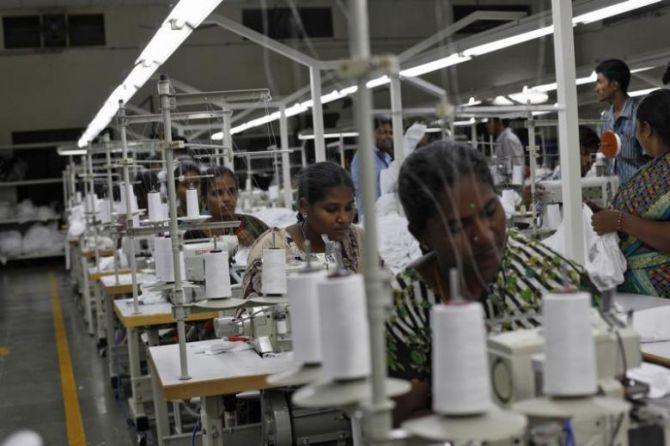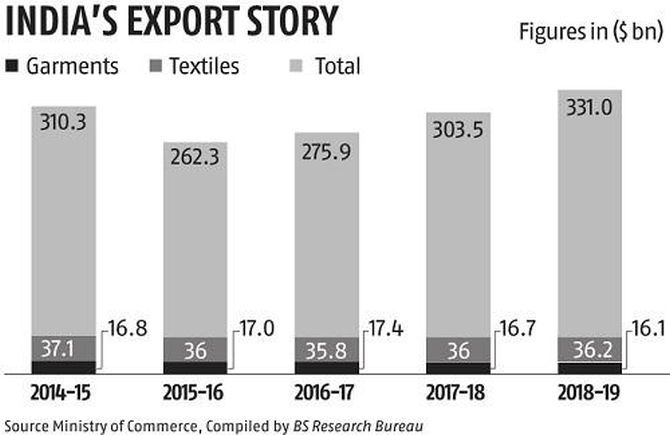In the last five years of NDA rule, 2018-2019 was the worst for exporters.
T E Narasimhan reports.

Textiles and readymade garment exports may see some recovery after a poor run of five years if exporters stand up to the challenges.
Industry insiders say the fall in exports was due to India's textiles not being competitive enough, buyers insisting on several compliance norms for which a large part of industry was not prepared and other trade issues.
There could be a recovery if the product base diversified, orders are delivered faster and compliance improves.
Exports of Ready Made Garments are under pressure.
Exports dropped 3.46% to $16.37 billion in 2018-2019 from $16.7147 billion in the year-ago period.
India's garments were 10% to 15% costlier than other competing countries.
Indian exporters are also over dependent on a narrow product base.
This made matters worse.
In the last five years of NDA rule, 2018-2019 was the worst for exporters.
Textiles, especially the garments sector, has been a major employment generator with 45 million being employed directly and 20 million being employed indirectly.
Meanwhile, exports from Vietnam and Bangladesh grew 11.19% and 13.7%, respectively, in 2018-2019.
Care Ratings said, 'Bangladesh, Sri Lanka, Vietnam have low production cost and exporters there enjoy preferential duty access in key markets.' This also contributed to making India's exports less attractive.
According to the Tirupur Exporters Association, which represents $3.72 billion of knitwear exports, 'Under the goods and services tax, there was almost a 7% reduction in the incentives that earlier helped exporters to be cost competitive. Incentives were withdrawn after the implementation of GST.'
Indian exporters face higher trade barriers compared to countries like Bangladesh, Vietnam and Pakistan in key markets such as the United States and the European Union.
Average tariffs levied on Indian textile exports are around 5.9% in the EU while it is 6.2% in the US, compared to 0% and 3.9% on exports from Bangladesh.
The US and EU are the world's largest apparel importers and account for 60% of total global imports.
Employee costs in India grew from 9% in financial year (FY) 2010 to 13% in FY 2018, while in other countries either it saw a stable or a marginal growth.
Exporters feel they would not be able to compete with Bangladesh and Vietnam and are now focussing on diversifying their markets to countries like Japan, Israel, South Africa, Hong Kong and others.
However, according to a large corporate exporter, the sector should reduce its over-dependence on cotton casual wear to be able to cater to global markets better and increase exports.

India is not a major competitor in man-made fibre or polyester-based garment segments and doesn't have the capacity to make winter-wear, active wear, sportswear etc.
Formal clothing accounts for a major chunk of the global trade.
Rahul Mehta, president, Clothing Manufacturers Association of India, says specialised performance garments such as polyester-based shirts, suits, jackets, woollen clothes, leather garments and hard winter-wear, are not part of India's export basket.
Indian textile exports are primarily dependent on a product basket of limited summer and casual wear that includes cotton shirts, t-shirts, cotton blouses etc.
CARE estimates that exports will remain subdued in the near future, growing marginally in rupee terms, and declining in US dollar terms due to competitive pressures from other countries.
India needs to increase its production of MMF-based apparels to remain competitive.
"I feel we are finally turning the page after about three or four years of stagnancy or slight de-growth. Monthly export charts show a year-on-year growth from October onwards.
Support from the government has gone up," says Mehta.
"Exports from Bangladesh are becoming expensive and Vietnam is showing signs of reaching the peak of its capacity," adds Mehta.
Buyers are getting more stringent on compliance and seeking faster delivery as market dynamics and preferences are changing faster than before.
Indian textile exporters have to adjust and deliver products faster if exports are to revive.












 © 2025
© 2025